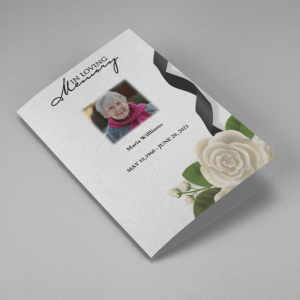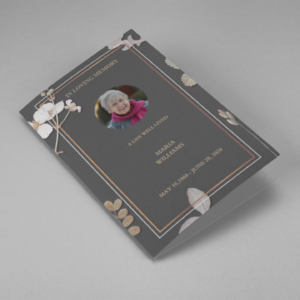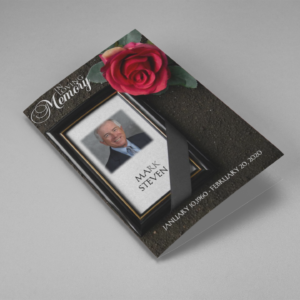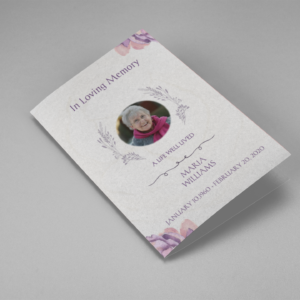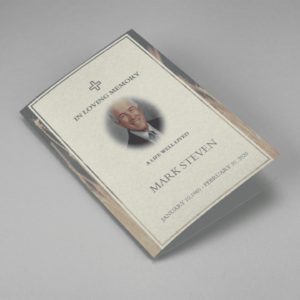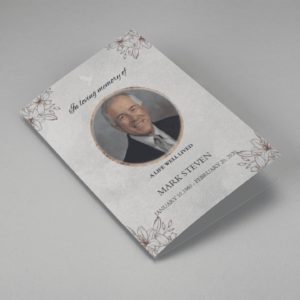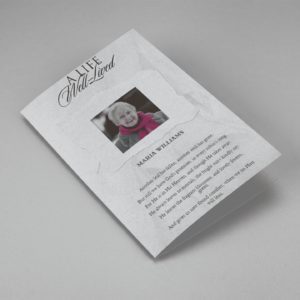The memorial or commemorative service is the most involved, complicated, and expensive service. One of the major problems facing today’s funeral industry is that, based on the traditional funeral culture many funeral providers invested in large and elaborate facilities complete with chapels and viewing rooms that focused on having an embalmed body open to public viewing in a casket. Today, more people are moving in the opposite direction and prefer a closed casket or a container designed only for burial or cremation. A service may include cremated remains in a small urn or no body or ashes present. It may take the form of a gathering of friends and family in any location and with a secular rather than religious remembrance service. These options reflect the public’s change of attitude in dealing with death. Today’s memorial service is more diverse, simple and, as a result, is less expensive.
-
Searching for a White Roses And Black Ribbon Funeral Program Template that is easy to print and has a cutting-edge look? White Roses And Black Ribbon Funeral Program Template is the Perfect decision because it measures 8.5”x 11”.
- No Limitation on Content, Edit anything
- Edit anytime – unlimited revisions even after purchased
- Get a printable PDF downloaded to get it printed on your own
-
Searching for a Realistic Burning Candle Funeral Program Template that is easy to print and has a cutting-edge look? Realistic Burning Candle Funeral Program Template is the Perfect decision because it measures 8.5”x 11”.
- No Limitation on Content, Edit anything
- Edit anytime – unlimited revisions even after purchased
- Get a printable PDF downloaded to get it printed on your own
-
Searching for a Bulltongue Arrowhead Funeral Program Template that is easy to print and has a cutting-edge look? Bulltongue Arrowhead Funeral Program Template is the Perfect decision because it measures 8.5”x 11”.
- No Limitation on Content, Edit anything
- Edit anytime – unlimited revisions even after purchased
- Get a printable PDF downloaded to get it printed on your own
-
Searching for a Grey Floral White Tiny Flower Funeral Program Template that is easy to print and has a cutting-edge look? Grey Floral White Tiny Flower Funeral Program Template is the Perfect decision because it measures 8.5”x 11”.
- No Limitation on Content, Edit anything
- Edit anytime – unlimited revisions even after purchased
- Get a printable PDF downloaded to get it printed on your own
-
Searching for a Red Flower Dark Soil Funeral Program Template that is easy to print and has a cutting-edge look? Red Flower Dark Soil Funeral Program Template is the Perfect decision because it measures 8.5”x 11”.
- No Limitation on Content, Edit anything
- Edit anytime – unlimited revisions even after purchased
- Get a printable PDF downloaded to get it printed on your own
-
Searching for a Pink Rose Frame Floral Oval Badge Funeral Program Template that is easy to print and has a cutting-edge look? Pink Rose Frame Floral Oval Badge Funeral Program Template is the Perfect decision because it measures 8.5”x 11”.
- No Limitation on Content, Edit anything
- Edit anytime – unlimited revisions even after purchased
- Get a printable PDF downloaded to get it printed on your own
-
Searching for a Brown and White Classic Funeral Program Template that is easy to print and has a cutting-edge look? Brown and White Classic Funeral Program Template is the Perfect decision because it measures 8.5”x 11”.
- No Limitation on Content, Edit anything
- Edit anytime – unlimited revisions even after purchased
- Get a printable PDF downloaded to get it printed on your own
-
Searching for a Purple Elegant Watercolor Funeral Program Template that is easy to print and has a cutting-edge look? Purple Elegant Watercolor Funeral Program Template is the Perfect decision because it measures 8.5”x 11”.
- No Limitation on Content, Edit anything
- Edit anytime – unlimited revisions even after purchased
- Get a printable PDF downloaded to get it printed on your own
-
Searching for a Cream and Green Photo Obituary Program that is easy to print and has a cutting-edge look? Cream and Green Photo Obituary Program is the Perfect decision because it measures 8.5”x 11”.
- No Limitation on Content, Edit anything
- Edit anytime – unlimited revisions even after purchased
- Get a printable PDF downloaded to get it printed on your own
-
Searching for a Cream Simple Elegant Photo Church Program that is easy to print and has a cutting-edge look? Cream Simple Elegant Photo Church Program is the Perfect decision because it measures 8.5”x 11”.
- No Limitation on Content, Edit anything
- Edit anytime – unlimited revisions even after purchased
- Get a printable PDF downloaded to get it printed on your own
-
Searching for a Grey Classic Minimalist Funeral Program Template that is easy to print and has a cutting-edge look? Grey Classic Minimalist Funeral Program Template is the Perfect decision because it measures 8.5”x 11”.
- No Limitation on Content, Edit anything
- Edit anytime – unlimited revisions even after purchased
- Get a printable PDF downloaded to get it printed on your own
-
Searching for a White Classic Funeral Program Template that is easy to print and has a cutting-edge look? White Classic Funeral Program Template is the Perfect decision because it measures 8.5”x 11”.
- No Limitation on Content, Edit anything
- Edit anytime – unlimited revisions even after purchased
- Get a printable PDF downloaded to get it printed on your own
Perhaps the best way to show the difference between a traditional funeral and the modern approach would be to describe the former and to show the options and choices now available in the latter.
With a traditional funeral, you paid for all the services whether or not you used them. The price, however, was solely determined by your choice of casket. Today, you may buy a preset package of traditional services or you may choose services and goods individually to form your own personally designed package, which do not include funeral memorial program or printing prices. Funeral memorial programs can get into the hundreds, if not thousands, depending on the service provider.
The traditional funeral of the past The normal sequence of arrangements was as follows:
- The body was removed from the place of death and automatically embalmed, unless a rare no embalming order was given to the funeral director.
- The family attended a first conference with the funeral director, which was held in either the family home or at the funeral home.
- All information was collected to facilitate the completion of the required documents for a certificate of death and a burial or cremation permit. Cremation was usually available only in large centers.
- Newspaper notices and obituaries were written by the funeral home and released To the appropriate newspapers or radio stations.
- Clothes were obtained and the body was dressed, cosmetics applied, and prepared for placement in a casket.
- The person (s) responsible chose a casket and may have added an outer container to be placed in the grave (a wooden box, or a concrete or metal vault).
- The body. was placed in a viewing room or chapel for public or private visitation.
- The family met with clergy to plan the program of the service.
- Final arrangements were made with the family for such details as the placement of people in the church or the funeral cortege, disposition of flowers after the funeral, return of valuables on the body, and final check of pallbearers’ names.
- The funeral register was delivered to the home, if necessary, along with the acknowledgment cards.

QuickFuneral.com offers the largest selection of Funeral Memorial Programs. We are highly recommended for the most beautiful templates of Funeral Programs that tell your loved one’s life story by 1000s of our loving customers.

